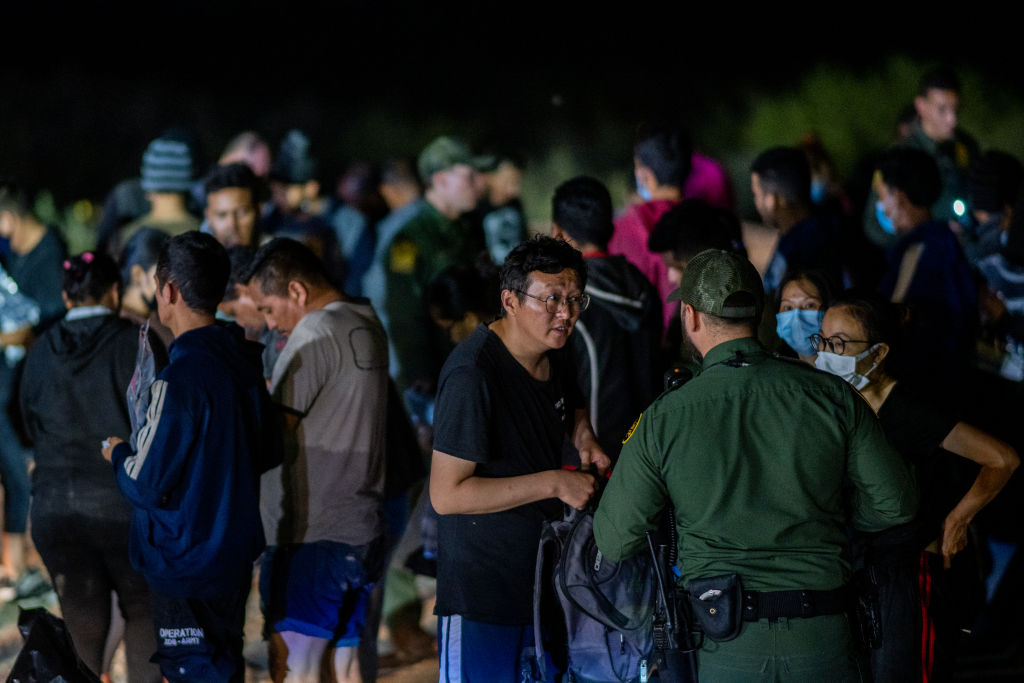Most migrants attempting to cross the U.S.-Mexico border hail from Latin America. But a growing number of Chinese asylum seekers have shown up at the United States’ southern border after making a dangerous overland trek through Latin America.
That someone from China would choose to travel through as many as 10 countries—including 2,500 miles overland through Central America alone, with some of that on foot—to get to America might seem mind-boggling. But for many in China, safer routes—such as arriving via a direct flight and claiming asylum—are not an option.
“If you’re applying for asylum, you just have to set foot on U.S. soil,” Adam Isacson, director for defense oversight with the human rights nonprofit, the Washington Office on Latin America (WOLA), tells The Dispatch. “And unfortunately, this may be the easiest way to do that for a lot of people, especially if they don’t have a lot in their bank account.”
What route do they take?
Planning the flight from China involves some ingenuity, because it requires circumventing the country’s great firewall. The information available on social media—typically on Douyin, the Chinese counterpart to Tiktok— is often coded, Reuters reported. Users who have successfully made the trip share information using the hashtags “The Route” and “The Big Beautiful,” referring to the Latin American route and the United States, or make generic references to planning a safari or jungle trip.
Typically, Chinese citizens without a visa fly first to Hong Kong. From there, many fly to Ecuador, which is the only South American country that doesn’t require a visa for Chinese travelers. Brazil also has more lax visa policies. Once they make it to the continent, they’ll travel north to the U.S.-Mexico border via bus, car, and on foot.
That migration path involves navigating the dangerous Darién Gap bordering Colombia and Panama. The roadless crossing is 60-plus miles of jungle, swampy ground, and mountainous terrain and can take up to 10 days to cross, especially if small children are in tow. Navigating from Ecuador to Panama means hiring a guide, which can cost migrants upward of $1,200 per adult and $700 per child, according to Reuters. The Wall Street Journal reported much more expensive rates, from $7,000 to $10,000.
How big of a trend is this?
Chinese citizens make up a small fraction of the migrants traversing Latin America en route to the U.S.-Mexico border, but the number has ticked up significantly. During the first six months of fiscal year 2023 it’s up 7,000 percent over the same time period in 2021, from 92 to 6,664, according to WOLA.
“It’s really a part of a much broader trend—the number of people coming from very far away has exploded in recent years and the Chinese phenomenon is just part of that broader set of trends,” David Bier, associate director of immigration studies at the libertarian Cato Institute, tells The Dispatch.
Use of the jungle route has exploded in recent years. That pathway was “almost not used until 2021,” Isacson observes. “Now there’s more than 40,000 people a month.”
Bier and Isacson point to a group of Haitian refugees living in Brazil and Chile who traveled on foot to the U.S.-Mexico border in 2021 as kicking off the increase in migrants traveling overland through Latin America: They had been living in Latin America for years following the 2010 earthquake, and many faced discrimination or lack of economic opportunity. “There was just no other option for them,” Isacson says.
That demand created a smuggling network. “All of a sudden you had people—many of them on the shady side of the law—specialized in helping to facilitate this for a fee,” Isacson says.
Cue the spike in migration.
From 2010 to 2021, fewer than 400 Chinese nationals traversed the dangerous Darién Gap bordering Colombia and Panama. In 2022, more than 2,000 came. And in the first two months of 2023 alone, more than 2,200 Chinese nationals came into Panama from the Darién Gap, according to Panama’s government.
Why are people fleeing China?
One of the reasons for the recent surge is the country’s country’s slow economic recovery from COVID-19: A number of small business owners saw their livelihoods “crushed during the COVID lockdown,” they told Reuters.
But others fled for different reasons. One group of Chinese migrants told the Wall Street Journal they wanted better economic opportunities or to avoid harassment from Chinese officials for supporting democracy protests in Hong Kong.
Bier notes that U.S. courts have ruled in favor of Chinese asylum seekers claiming persecution at much higher rates than other groups. From 2000 to 2021, Chinese asylum seekers were the third-most successful group in immigration courts, with a 67 percent acceptance rate, according to the Transactional Records Access Clearinghouse, a data and research group at Syracuse University.
Those granted asylum can apply for work permits and work legally in the U.S. after 180 days.
“Many of these people are going to have very plausible asylum claims,” Bier notes. “Persecution is quite pervasive.”
Most Chinese asylum seekers Isacson’s spoken to have mentioned persecution, and some mentioned corruption. “In general, it was persecution more than economics,” Isacson says. “A lot of the Chinese coming are Christians.”
Reuters reported that some of those fleeing carried Chinese-language Bibles or wore crosses. While China’s constitution says citizens “enjoy freedom of religious belief,” in practice, it heavily regulates religious activity, including requiring clergy to pledge allegiance to the Chinese Communist Party and forbidding those under 18 to attend church.
The U.S. Commission on International Religious Freedom (USCIRF) reports that China’s sophisticated surveillance system tracks religious activity, and the government routinely intimidates, harasses, and persecutes Christians, Tibetan Buddhists, Falun Gong, and other religious minorities. The crackdown on Uyghur Muslims has been particularly severe: More than 1.8 million Muslims in China are detained in concentration camps in Xinjiang.
How will the Biden administration’s new immigration policies impact them?
The expiration of Title 42 and a shift in the Biden administration’s immigration policies may bring fewer Chinese asylum seekers via the Latin America route in the coming weeks.
“The new asylum restriction will in fact apply to any Chinese nationals who do not meet the new standards,” Aaron Reichlin-Melnick, policy director with the American Immigration Council confirmed.
The Biden administration’s recent adoption of what is essentially a transit ban means anyone crossing into the United States between ports of entry or traveled through another country en route to the United States without first seeking asylum there faces a presumption of “asylum ineligibility.” From there, they face expedited removal proceedings.
The Biden administration’s current policy requires those wanting to cross the border to wait in Mexico and schedule an appointment via a mobile app. But it does not currently have a Chinese-language option.
It’s unclear what will happen to Chinese nationals who make it into the United States but are deemed ineligible for asylum: The United States does not have a formal extradition treaty with China, making it difficult for U.S. authorities to deport those with rejected asylum claims.
“People from China fleeing persecution from the authoritarian communist regime have the right to make their claim before an asylum officer,” Bilal Askaryar with the Women’s Refugee Commission says to The Dispatch. “President Biden’s asylum ban means the only way they can do that is if they are rich enough to buy a one-way ticket into the U.S.”









Please note that we at The Dispatch hold ourselves, our work, and our commenters to a higher standard than other places on the internet. We welcome comments that foster genuine debate or discussion—including comments critical of us or our work—but responses that include ad hominem attacks on fellow Dispatch members or are intended to stoke fear and anger may be moderated.